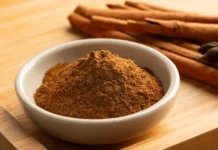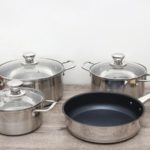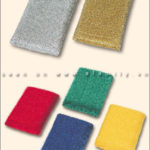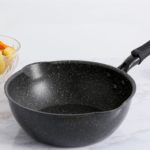A pan is a staple in every kitchen. To prolong the lifespan of a pan, it is common to season it. In this article, we will explain why it is necessary to season a new pan and how to do it to create a non-stick and durable surface.
1 What is Pan Seasoning?
Pan seasoning is a process of coating a pan with oil and heating it at a high temperature to create a new non-stick layer. This method can be applied to both new and old pans, helping to prevent rust and improve non-stick performance, making cooking easier.
When seasoning a pan, the oil’s fat will adhere to the pan’s surface. When heated at a high temperature, the fat will transform and create a protective layer. This method is typically used for cast iron, stainless steel, and carbon steel pans.
 Pan seasoning helps prevent rust and corrosion.
Pan seasoning helps prevent rust and corrosion.
2 Why is it Necessary to Season a New Pan?
As mentioned, pan seasoning helps with long-term pan preservation, preventing rust, and enhancing non-stick performance. Therefore, it is a necessary process.
However, it is important not to overuse or misuse the seasoning method. The following are appropriate times to season your pan:
When You Buy a New Pan
Although pans purchased from the market have been pre-seasoned or coated with a non-stick layer by the manufacturer, seasoning your new pan yourself will undoubtedly improve its non-stick properties.
 Season your new pan before first use.
Season your new pan before first use.
When You Don’t Use the Pan Regularly
If a pan is left unused for an extended period, it may develop stickiness when frying or sautéing. Therefore, it is recommended to season the pan with oil before using it again to improve its non-stick properties.
 Season your pan if it hasn’t been used for a while.
Season your pan if it hasn’t been used for a while.
When the Pan Loses its Non-Stick Coating
Over time, the non-stick coating of a pan can become scratched or peel off due to frequent exposure to acidic ingredients like tomatoes, vinegar, and lemon juice. To mitigate and resolve this issue, it is recommended to season the pan with oil every 3 to 4 months.
However, if the non-stick coating is severely damaged, causing food to stick and burn, it is advisable to replace the pan to protect your family’s health.
 Season your pan if it has lost its non-stick coating.
Season your pan if it has lost its non-stick coating.
3 How to Season a Pan for a Non-Stick and Durable Surface
Seasoning a Stainless Steel Pan on a Stovetop
For a new pan, simply rinse it with warm water. For a pan that has been in use, clean it with diluted dish soap and then rinse thoroughly with water.
 Clean the pan for the first time.
Clean the pan for the first time.
Place the pan on the stove and heat it over medium heat for about 10 to 15 minutes to evaporate any remaining water and remove moisture. Then, turn off the heat and let the pan cool down.
 Dry the pan on the stovetop for the first time.
Dry the pan on the stovetop for the first time.
Once the pan has completely cooled, place it under cold running water and clean it again. Then, dry it with a clean, soft cloth.
 Clean and dry the pan a second time.
Clean and dry the pan a second time.
Again, place the pan on the stove and heat it over medium heat for about 10 to 15 minutes.
 Dry the pan on the stovetop a second time.
Dry the pan on the stovetop a second time.
Add about 3 soup spoons of oil to the pan and rotate the pan to evenly coat the entire surface. Heat the oil until it starts to smoke, then turn off the heat and let the pan cool down.
 Season the pan with oil.
Season the pan with oil.
Pour out the excess oil and wipe the pan dry with a soft cloth or paper towel. Do not rinse the pan with water. Your pan is now seasoned and ready to use!
 Wipe out the excess oil and dry the pan.pan>
Wipe out the excess oil and dry the pan.pan>
Seasoning a Cast Iron Pan in the Oven
Clean your cast iron pan using the same method as for the stovetop method:
- New Pan: Rinse with warm water and dry with a soft cloth.
- Pan in Use: Clean with diluted dish soap, rinse with water, and dry thoroughly.
 Clean and dry the cast iron pan.
Clean and dry the cast iron pan.
Once the pan is completely dry, apply a thin layer of oil to the pan’s cooking surface, exterior, and handle.
Pro Tip
Use oils with a high smoke point, such as canola, grapeseed, or peanut oil, for better adhesion and a superior non-stick surface.
 Coat the pan with oil.
Coat the pan with oil.
Place a sheet of aluminum foil on the bottom rack of your oven and place the pan upside down on the rack above. Bake the pan for about an hour at a temperature between 180 and 200 degrees Celsius. Then, let the pan cool down for about 5 to 10 minutes before removing it from the oven.
 Bake the pan in the oven.
Bake the pan in the oven.
Repeat the entire seasoning process 2 to 3 times until the pan develops a dark, shiny coating.
 Pan before and after seasoning.
Pan before and after seasoning.
4 How to Use and Care for a Newly Seasoned Pan
Here are some important tips to keep in mind when using and caring for your newly seasoned pan to maintain its durability and non-stick properties:
- Always preheat the pan before frying or sautéing food.
- Only clean the pan when it has completely cooled down.
- Never pour cold water into a hot pan, as it can cause the pan to crack or warp.
- Use warm water, mild dish soap, or baking soda to clean a newly seasoned pan.
- Avoid using abrasive cleaning tools, as they can scratch or remove the non-stick coating.
- Always dry the pan thoroughly and store it in a cool, dry place to prevent rust.
 Use a soft cloth to wipe your newly seasoned pan.
Use a soft cloth to wipe your newly seasoned pan.
We hope this article has provided you with valuable information about pan seasoning and how to season a new pan for a non-stick and durable surface. Happy cooking!





































